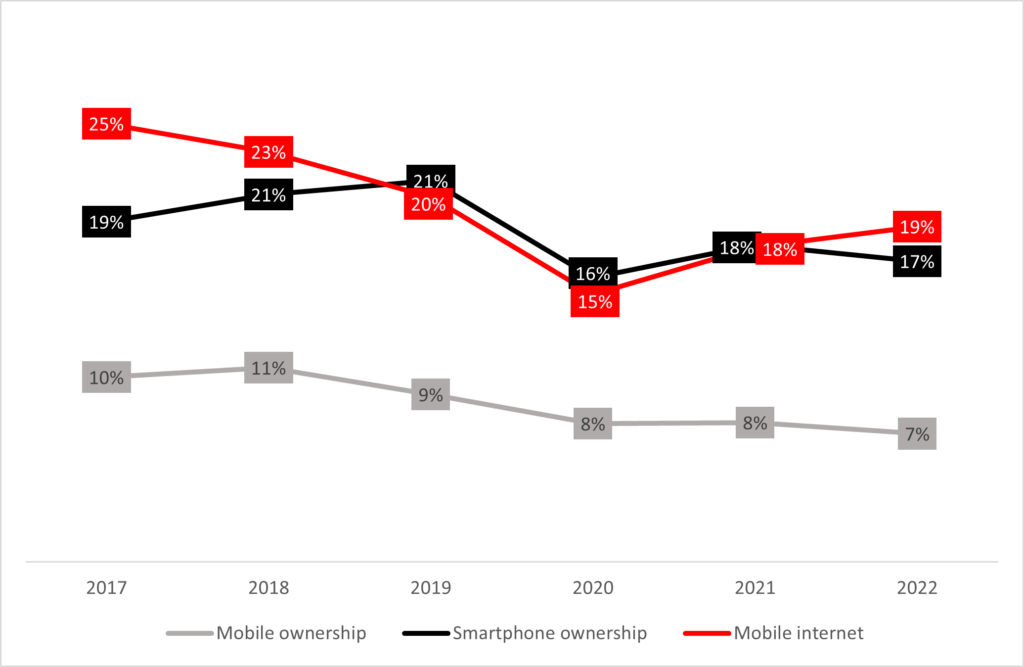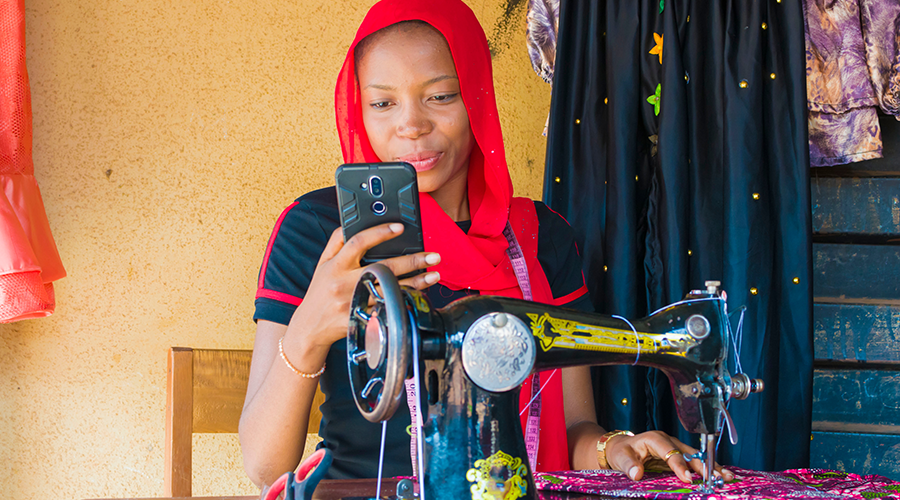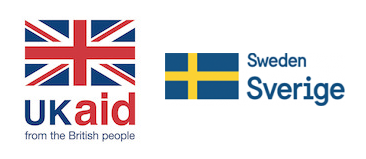Women’s rate of mobile internet adoption has slowed for the second year in a row
In low- and middle-income countries (LMICs), mobile phones are the primary and often only way people get online, especially women. More than 3.4 billion people in LMICs now access the internet on a mobile phone[1], but significant gender gaps remain.
Our Mobile Gender Gap Report 2023 highlights that while more women across LMICs are using mobile internet than ever before, their rate of adoption has slowed even more than the previous year. In last year’s report we highlighted that, for the first time since GSMA started tracking it, the gender gap in mobile internet across LMICs did not reduce. This was a result of women across LMICs adopting mobile internet at a slower rate than men. Now, men’s rate of adoption has also slowed compared to 2021 and as a result, the size of the mobile internet gender gap remains relatively unchanged. Women are 19% less likely than men to use mobile internet (see Figure 1).
Similarly, the gender gaps in mobile ownership and smartphone ownership remain relatively unchanged for the second year running, with women still 7% less likely to own any type of phone and 17% less likely to own a smartphone (see Figure 1). The slowdown in digital inclusion for women, and now also for men, and the fact that mobile gender gaps are not reducing is concerning.
Figure 1: Gender gaps in mobile ownership, smartphone ownership and mobile internet adoption across LMICs, 2017-2022

Across LMICs, an estimated 900 million women are still unconnected and not using mobile internet, with almost two thirds of these women living in either South Asia or Sub-Saharan Africa. These are also the regions where mobile gender gaps are widest at 41% and 36%, respectively. South Asia was the only region that had seen any notable shifts in the mobile internet gender gap since 2017, driven primarily by changes in India. However, this year, there has been no significant change in any regions, including South Asia, highlighting that more attention, action and investment is needed everywhere to tackle this slowdown in women’s digital inclusion.
Driving women’s digital inclusion requires addressing multiple barriers
The mobile gender gap is driven by a range of social, economic and cultural factors, which result in women experiencing barriers to mobile ownership and use more acutely than men. Understanding these barriers is essential if we are to drive digital inclusion and close the substantial and stubborn gender gaps.
The top-reported barriers to mobile ownership remain similar for men and women. These are affordability, literacy and digital skills and lack of perceived relevance. Women who don’t own a phone were more likely than men to report that accessing someone else’s phone meant they didn’t feel they needed their own.
Awareness of mobile internet is a critical step in the mobile internet user journey. Whilst women are still less likely than men to be aware of mobile internet, awareness levels are relatively high with over 80% of men and women aware of it in nine of 12 survey countries (awareness remains lower in Ethiopia, India and Bangladesh). However, mobile internet awareness does not always translate to adoption. There are many people, particularly women, who are mobile users and are aware of mobile internet but do not use it, suggesting other barriers are preventing them from doing so.

Across survey countries the top barrier to mobile internet adoption for men and women who are already aware of it is affordability, particularly of internet-enabled handsets, followed by literacy and digital skills, primarily difficulties with reading and writing. Safety and security ranked third and was reported to a lesser degree.
While the barriers men and women face are quite similar, the gender gap in mobile internet adoption means that there are millions more women than men who experience these barriers. Furthermore, analysis shows that even when women have the same levels of education, income, literacy and employment as men, they are still less likely to use mobile internet, suggesting that other issues are at play, such as discrimination and social norms. As such, addressing these barriers is likely to enable disproportionately more women to get online.
The mobile gender gap will not close on its own
Enabling women to access and use mobile is crucial and can provide significant social and commercial benefits. The GSMA estimates that closing the gender gap in mobile ownership and use in LMICs by 2030 would deliver $230 billion in additional revenue to the mobile industry. Furthermore, for women who use mobile internet the benefits are clear. In each of our 12 survey countries, the majority of female mobile internet users reported that using mobile internet had positively impacted their lives overall. A similar proportion of women and men reported this, suggesting that when women start using mobile internet, it improves their lives to a similar degree.
To close the mobile internet gender gap by 2030 across LMICs an estimated 810 million women need to start using it – this is equivalent to 100 million women a year, on average. However, the unfortunate reality is that with the rate of digital inclusion slowing across LMICs, the mobile internet gender gap will not close on its own. If the gender gap remains unchanged, forecasts suggest that only 360 million more women will adopt mobile internet by 2030, falling far short of the 810 million women needed.
In an increasingly connected world, it is critical that no one is left behind, but women are being left behind – a challenge that must be met head on. When women thrive, societies, businesses and economies thrive.
Read our latest GSMA Mobile Gender Gap Report 2023 for more detailed findings and recommendations.
[1] GSMA Intelligence, Q4 2022

The Connected Women programme is funded by the UK Foreign, Commonwealth & Development Office (FCDO) and the Swedish International Development Cooperation Agency (SIDA), and is supported by the GSMA and its members.


